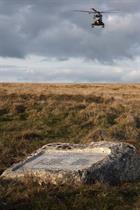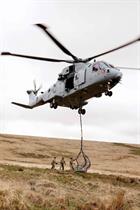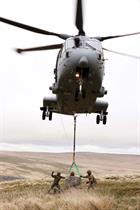Commando helicopters deliver memorial for US aviators killed in WW2
Commando fliers helped park rangers on Dartmoor formally recognise wartime aviators killed just days and yards apart.
They delivered two cumbersome memorial stones with pinpoint accuracy to the spots where 15 Americans died as they returned to base from front-line missions in December 1943.
Five men aboard a US Army Air Force B-17 Flying Fortress died when their aircraft crashed on Corn Ridge on the western side of Dartmoor, near Sourton Tors.
The aircraft had been on a Christmas Day weather reconnaissance flight from St Eval in Cornwall and was heading back to its base in Buckinghamshire but crashed into the hillside in low cloud. Three men survived the crash.
Just three days later, tragedy visited the moor again as a B-24 Liberator returned to Dunkeswell airfield near Honiton.
With a formation of 14 other US Navy Liberators it had carried out a sweep of the Bay of Biscay, looking for German destroyers.
They fought off at least two Luftwaffe fighters before heading back to Devon. In dense clouds it ploughed into rocky ground, breaking apart, burning up and killing all ten souls aboard.
Commemorating the two crashes has long been the goal of Dartmoor National Park Authority ranger Ian Brooker, who first became aware of the wreckage sites 30 years ago and has always wanted to formally mark the tragedies.
“It’s always been a real dream of mine to remember in stone the losses of the USAAF and the USN aircrews in December 1943, and this is a proper tribute to their sacrifice,” he said.
Stones were provided by the Duchy of Cornwall, funded by the national park and the MOD, while 846 Naval Air Squadron – more used to ferrying Royal Marines and their kit around – offered to help as part of their training exercise, Wessex Tor.
Lifting the stones into place was undertaken by the squadron’s Merlin Mk4s, assisted on the ground by the experts of the Commando Mobile Air Operational Team (MAOT), who normally set up forward bases supporting Commando Helicopter Force operations in the field.
“It was a particularly tricky operation for us,” said Lieutenant Commander Gordon Smith, officer in charge of the MAOT.
“We had to get the stones into a suitable net which could be underslung from a Commando Merlin, flown to the remote moorland site and then slowly and carefully lowered into exact positions at the sites of both crashes. Such live tasks provide invaluable and rewarding training for the Commando Merlin crews and Commando MAOT.”
The next act will be to formally dedicate the stones ahead of the 80th anniversary of the crashes.




